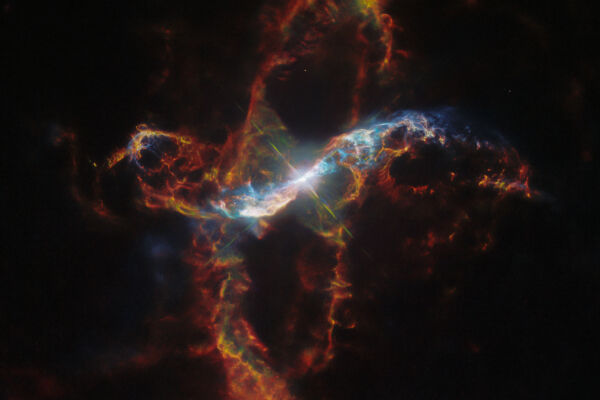The Hubble Space Telescope of the National Aeronautics and Space Administration (NASA) captured a special binary star system in the constellation of Aquarius known as R Aquarii. This system has undergone violent outbursts, spewing massive glowing gas filaments resembling volcanic eruptions in space, beautifully juxtaposed with surrounding nebulae.
According to a news release by NASA on October 16, R Aquarii is located only about 700 light-years away from Earth and consists of a red giant star and a white dwarf star, forming a symbiotic binary system, also the closest symbiotic binary system to Earth.
The extraordinary outbursts of R Aquarii have unleashed immense glowing gas filaments, making the region look like a lawn sprinkler wildly watering the surroundings. This dramatic display showcases how the universe redistributes nuclear energy produced within stars and expels it back into space.
The primary star of R Aquarii is an aging red giant star, while its companion is a dense white dwarf star. The red giant star is classified as a Mira Variable star, over 400 times larger than the Sun.
This gigantic red giant star undergoes pulsations and temperature changes within approximately a 390-day pulsation cycle, with its brightness varying up to 750 times. During its peak, the star’s brightness reaches nearly 5,000 times that of the Sun, truly dazzling.
As the white dwarf star orbits in a 44-year period and approaches the red giant star closely, it gravitationally siphons off hydrogen gas. This material accumulates in an accretion disc surrounding the white dwarf star until experiencing powerful explosions and eruptions, particularly during the closest approach to the red giant star.
These eruptions release powerful jets resembling filaments shooting out from the binary system, forming rings and tails. Plasma appearing in the form of electron flows twists due to the force of the explosion and is guided upwards and outwards by strong magnetic fields, appearing to bend into spiral shapes on its own.
These filaments emit light in visible light due to the intense radiation from R Aquarii providing them with energy. The surrounding nebula around the binary system is named Cederblad 211 and may be remnants of a previous nova (a star that undergoes a dramatic increase in brightness due to explosions).
Even from an astronomical perspective, the scale of this eruption event is extraordinary as the ejected material can be traced back to at least 400 billion kilometers from the center of the binary system (2500 times the distance between the Sun and Earth).
The research team of the Hubble Space Telescope first observed R Aquarii in 1990. They have created a time-lapse video from observations between 2014 to 2023 to showcase the dynamic behavior of the binary system. People can witness the rapid and dramatic evolution of these two stars and the surrounding nebula. Due to the intense pulsations of the red giant star, the binary system fluctuates between dim and bright.
Most of these nebulae appear green, with occasional sightings of bluer regions, illuminated only when beams of rotating binary, lighthouse-like lights sweep across them.
Similar images along with more captured by the Hubble Space Telescope will completely reshape people’s perceptions of unique celestial “volcanoes” like R Aquarii.
The Hubble Space Telescope, jointly operated by NASA and the European Space Agency (ESA), has been observing for over 30 years, continuously making significant discoveries.

